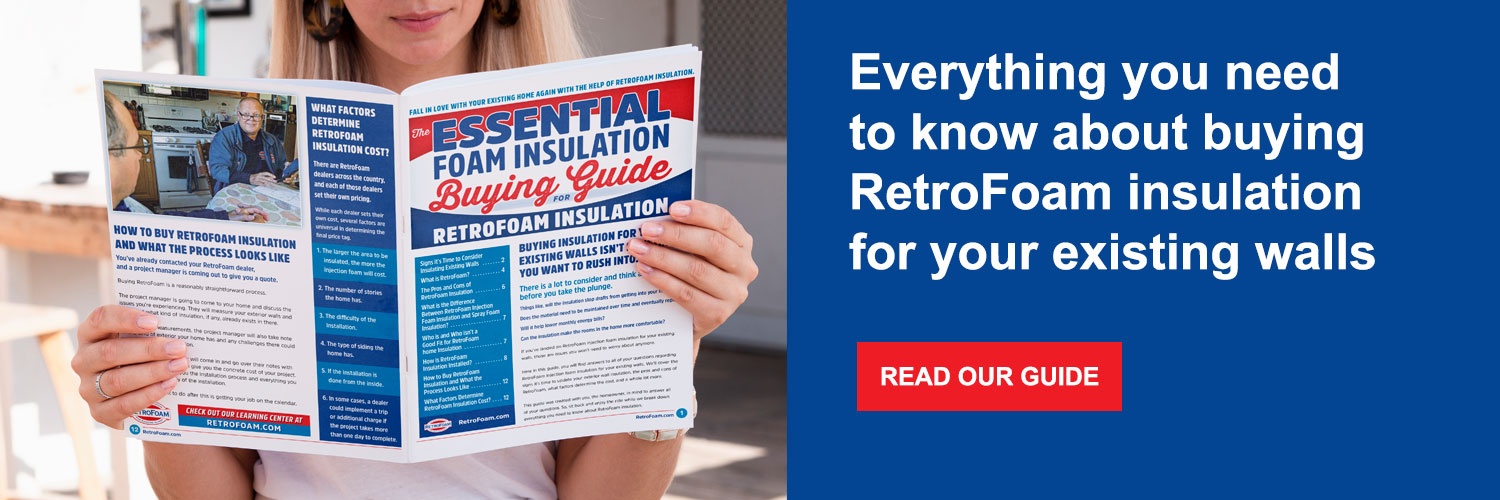Clearing Up Misconceptions About Injection Foam Insulation
injection foam insulation | RetroFoam insulation | foam university


There is a lot of misinformation on the Internet about foam insulation, which in turn leads to homeowners having misconceptions.
Someone reads that adding foam insulation to existing walls will make the house too tight. That person tells a friend, and then that person tells a friend, and now everyone thinks this is the gospel.
The injection foam insulation and spray foam insulation you think you know may not exist. Over the years, foam insulation has changed quite a bit, so things that were true 20 to 30 years ago just aren’t the case today.
There are a lot of manufacturers of foam insulation, so you can’t really compare those apples to apples.
You’ve found RetroFoam insulation on the web, so we can at least clear up the misconceptions you have about our injection foam. We have been in the business of making injection foam insulation for more than 35 years and have helped homeowners across the country make their homes more comfortable and energy-efficient.
We’ve heard a lot of misconceptions from homeowners, and we want to clear them up, so everyone has all of the correct information they need to make the best decision for their exterior wall insulation.
Popular Injection Foam Insulation Misconceptions
A misconception is a conclusion based on faulty thinking or facts that are wrong.
Here are the most popular misconceptions we hear about injecting foam insulation into existing walls.
Misconception: New wiring can't be added after foam insulation in existing wall cavities is installed.
RetroFoam injection foam is soft and pliable material, which means it is very easy to work with if you need to have any electrical work done in the future. The electrical wire can be pushed right through the foam with the use of fish tape.
Misconception: Foam insulation will make a house too tight.
When you’re concerned about your house being too tight, you’re more concerned about the air quality and humidity in your home.
In your existing home, this is actually pretty easy to fix. By turning on a bathroom fan or kitchen hood just once a day, you’re creating an air exchange in your house that has fresh air coming in. Adding a fresh air intake for your furnace is another option to allow fresh air into your home.
Misconception: Exterior walls can't be re-insulated with injection foam without tearing down drywall.
Your existing walls can be insulated without the need to tear out all of your drywall.
That’s because the installation can be done from the outside, no matter what kind of siding you have. And even if you decide to have the foam injected from the inside, it can be done just by drilling holes instead of a massive remodeling project.
Misconception: Foam insulation is flammable.
RetroFoam insulation is Class One Fire Rated.
This means the injection foam doesn’t act as a catalyst if there were a fire in your home. It also doesn’t promote the spreading of the flames and will self-extinguish once the flame is removed.
Misconception: Injection foam insulation will completely soundproof a room or home.
Injection foam insulation won’t completely soundproof your home, but it can work to make it quieter.
RetroFoam insulation can dampen sound up to 80 percent.
Another thing to keep in mind when reducing noise in your home is the location of your ductwork, pipes, appliances, and the construction of your home, as these are all sources of sound transfer from room to room.
Misconception: Adding insulation to exterior walls like foam is way more expensive than cellulose or fiberglass.
Injection foam insulation can typically be about two to three times more expensive than traditional insulation. Fiberglass and cellulose have a lifespan of about 15 to 20 years under ideal conditions and still allows for air leakage into and out of your home.
While it comes with a higher price tag, it doesn’t need to be replaced and constantly maintained to be effective.
Foam insulation actually saves you more money in the long run on monthly heating and cooling costs because of the air seal it creates.
Misconception: Existing exterior walls can be insulated through the top plate in the attic.
We have many ways to inject foam insulation into existing walls, but through the attic isn’t one of them.
The top plate in the attic is tough to get to, and it wouldn’t be possible to make sure the cavity was filled entirely from that far up. It also wouldn’t be possible for the installer to locate any obstructions in the wall cavity from that angle.
Misconception: The injection foam will seal the small gaps around the doors and windows.
Injection foam insulation will fill all of the cracks and crevices in the wall cavity, but it can’t get to those small areas around the doors and windows because they are closed off.
Applying caulk around the window and door trim will help prevent air leakage around your doors and windows.
Adding Injection Foam Insulation in Your Existing Walls
Now that we’ve cleared up these misconceptions for you, why not expand your knowledge on all things foam insulation?
Head on over to the Learning Center on our website, where you’ll find a ton of resources covering the installation process, frequently asked questions, energy savings, and a whole lot more.
Related Articles
Fishing Electrical Wire Through Insulated Walls with RetroFoam
What is the Difference Between RetroFoam Injection Foam and Spray Foam Insulation?
About Amanda Emery
Amanda previously has worked as a breaking news and crime reporter, TV news producer, and editor. As a journalist, she has won several awards from The Society of Professional Journalists - Detroit Chapter and the Michigan Press Association. Amanda uses her experience as a journalist to write content that will help educate homeowners on foam insulation benefits. When Amanda isn’t writing, she’s spending time with her husband Chris, daughter Lilith-Maeve, and rescued huskies Danger and Wendigo. She also loves knitting, making art, and cooking.


